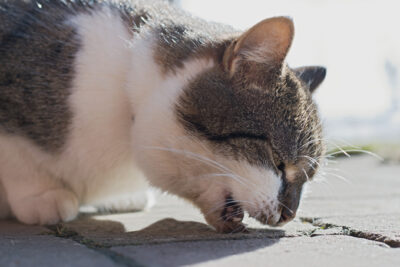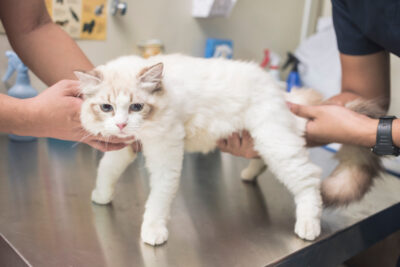Urinary Tract Infection (UTI) in Cats

Overview
- UTIs in cats are rare, but they are difficult to spot.
- Causes can include certain illnesses, stones or crystals, or even certain medications.
- Symptoms may include straining to urinate, urinating more frequently, blood in the urine, and more.
- Urinary tract infections require the use of antibiotics or in rare cases antifungal medication.
All featured products are chosen at the discretion of the GreatPetCare editorial team and do not reflect a direct endorsement by the author or reviewer.
Urinary tract infections (UTI’s) are tricky to spot in cats. Even though a UTI in cats is rare, it is important to know this condition since lack of treatment could result in spread of infection to the kidneys.
While nearly one-third of cats with UTIs will show no symptoms, others will become very ill. Cats often have an underlying condition that causes them to develop a UTI, so testing and investigation is critical.
Read more to navigate this complex disease in cats.
What Is a Cat Urinary Tract Infection?
A urinary tract infection (UTI) is when bacteria (or very rarely a fungus) infects the urinary system. The urinary system consists of the kidneys all the way to the genital tract. Urine flows through the system in this order:
- Kidneys
- Ureters
- Bladder
- Urethra (ends at the genitals)
A urinary tract infection is not the same as cystitis. Cystitis refers to inflammation of the bladder, which is a relatively common condition in cats. Urinary tract infections only occur in 1-3 percent of all cases of cystitis in cats and are considered a rare condition.
For unknown reasons, cats who are 10 years of age and older are much more likely to have a urinary tract infection than younger cats. No specific cat breeds are prone to UTIs.
While diet is important to control some urinary issues in cats, it is not known to cause or treat UTIs. For cats with a history of urinary crystals or bladder stones, a special prescription diet, such as Royal Canin Urinary SO, can reduce the risk of recurrence of certain types of crystals and stones.


Cats with a UTI often experience symptoms that make them very uncomfortable. Without appropriate treatment, infection can spread up to the kidneys. When this happens, a life-threatening condition called pyelonephritis can occur.
What Causes UTIs in Cats?
A cat’s urinary system is very good at preventing infection, and urine is typically sterile (without bacteria or fungi).
In cats, the following conditions may lead to urinary tract infections:
- Systemic illness, such as diabetes mellitus, kidney failure or hyperthyroidism
- Stones or crystals in the urinary system (urolithiasis)
- Urinary incontinence (inability to control urination)
- Abnormalities in the structure of the urinary system such as conditions of the penis or vulva (genitalia)
- Hospitalization requiring a catheter to be placed into the bladder
- Use of medications that decrease the immune system
Since there are no breeds predisposed to UTIs, there is no evidence that genetics cause urinary tract infections.
Signs of a Urinary Tract Infection in Cats
Symptoms of UTIs in cats are similar to cystitis, since both conditions cause general discomfort in the urinary system. It is important to note that not all cats show symptoms—in one study of cats with a UTI, 35 percent of cats showed no signs (1).
Below are the symptoms you might see:
- Urination outside of the litter box
- Change in frequency of urination (i.e. smaller amounts more frequently)
- Straining to urinate (i.e. standing in the litter box a long time and not urinating much if any)
- Vocalizing while urinating (meowing or howling)
- Change in color of the urine (darker yellow, brown or bright red)
- Increased drinking
- Increased volume (amount) of urine
- Change in normal behaviors – for example, hiding or eating less
- Licking genitalia more frequently (the area under the tail)
- Discharge from the vulva or prepuce (i.e. from the genitalia)
Diagnosing a Urinary Tract Infection in Cats

Veterinarians will need to run urine tests in order to diagnose this condition. A urinalysis is a basic first step to test the concentration of the urine and look for any abnormal cells or bacteria. Typically a veterinarian would note your cat’s urine has more water content (is more dilute) than usual, and may note blood, white blood cells (indicating inflammation), crystals and/or actual bacteria.
Not all urine samples show obvious infection or bacteria. In one study, up to 25 percent of urine samples did not show any bacteria, but UTI was diagnosed using a urine culture (2). A urine culture is when the veterinarian takes a sample of urine directly from the bladder. This sample of urine is sent to a laboratory and put onto a special plate meant to grow bacteria. After a couple of days, if there are no bacteria growing, then there is no evidence of a UTI. If bacteria begin to grow, the laboratory will run further testing to see which antibiotics the bacteria will respond to.
Blood work is also important for cats with a UTI because underlying systemic conditions are usually involved. Because stones in the urinary system can be a cause (or effect) of infections, X-rays are a common test as well as ultrasound to view the urinary system.
Cat UTI Treatment
Urinary tract infections require the use of antibiotics to treat them (or, in the very rare case of a fungal infection, antifungal medications). The choice of antibiotic is ideally based on culture results. If underlying systemic conditions are also present, treatment of the other condition is also required to allow the body to fight off the UTI.
Some cats have crystals in their urine and possibly stones in their urinary system. If this is the case, your veterinarian will recommend a prescription diet, such as Royal Canin Urinary SO. This veterinary-exclusive diet for adult cats is designed to support urinary tract and bladder health. It helps dissolve struvite stones and lowers risk of struvite and calcium oxalate crystal formation.


Medications to Treat Urinary Tract Infections in Cats
Common antibiotics used to treat cat urinary tract infections include:
- Amoxicillin (with or without clavulanic acid)
- Cefovecin (injection)
- Trimethoprim-sulfonamide
- Fluoroquinolones such as enrofloxacin, marbofloxacin or pradofloxacin
These medications are all available in pill or liquid form except for cefovecin, which is an injection. Most veterinarians will order liquid medications for pet parents to help with giving medications to cats. Some of the antibiotics need to be compounded, meaning specially made for your pet.
Cefovecin is not the best treatment choice for UTI in cats. It is an attractive option since one injection lasts for 10-14 days. But, cefovecin is not as effective against some of the types of bacteria typically seen in cat urinary tract infections. While it may not be the best choice, if a pet parent is unable to give medications by mouth to his/her cat, it may be the only choice available.
General Cost to Treat a Cat UTI
The cost to treat urinary infections in cats varies widely depending on what other underlying issues are present. To diagnose a urinary tract infection with a veterinary examination, it will cost around $100-$120. If a culture is needed, additional costs may be around $200.
However, other tests are typically needed to look for underlying reasons. These vary and can cost an additional $100 to $500, depending on what your cat needs.
Most veterinarians will recommend you return with your cat for a retest of the urine to ensure the infection is gone before antibiotics are over. This is a critical step, because if the infection is not gone when antibiotics are stopped the infection will immediately come back and perhaps get even worse than the first time. This re-test will likely cost around $50.
If your veterinarian recommends a urinary prescription diet for your cat, such as Royal Canin Urinary SO, it can cost approximately $75-$100 per month. You would need to feed your cat the prescription diet for the rest of their life. There are no over-the-counter diets that prevent crystals and stones.
Holistic Remedies for a Cat UTI
There are many holistic remedies that are intended to decrease inflammation in the bladder. However, these remedies will not cure or appropriately treat a bacterial infection. Using holistic remedies along with antibiotics may help increase your cat’s comfort and decrease the chance of recurrence. Ideally, seek a holistic veterinarian for treatment.
Examples of holistic treatments for a cat UTI include:
- High quality canned food diet (eliminate dry food diets)
- Cranberry extract
- Acupuncture
- Commercially available herbal therapies for cystitis
- Veterinary herbal therapies (like choreito)
- Chinese herbal therapies (like Ba Zheng San)
Please speak with a veterinarian before giving your cat any supplements or herbal remedies. If given incorrectly these remedies could be harmful for your cat.
How to Prevent Cats from Getting a Urinary Tract Infection

While not all urinary tract infections in cats can be prevented, there are steps you can take to help your feline avoid urinary issues.
Preventive measures may involve:
- Annual or biannual veterinary examinations to identify underlying conditions early on.
- Taking your cat to the veterinarian as soon as there are changes in behavior or medical status such as appetite or activity level.
- Treatment and long-term management of systemic illness.
- Surgery of the genitalia if there is abnormal structure.
- Keeping your cat at a healthy weight can prevent diabetes, which is a risk factor for urinary tract infections.
Related Conditions
- Pyelonephritis (infection of the kidneys)
- Cystitis (inflammation of the bladder)
- Diabetes mellitus
- Kidney failure
- Hyperthyroidism
- Hyperadrenocorticism
- Urinary stones (urolithiasis)
- Urinary incontinence









